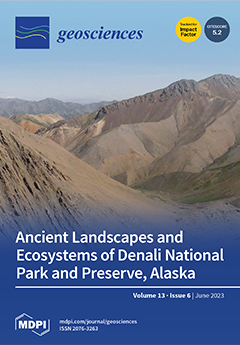One of the most extensively studied topics in dozens of studies is the alteration process of ilmenite, the formation of leucoxene, and the presence of some impurity oxides: SiO
2 and Al
2O
3. The altered Egyptian black sand ilmenite grains of relatively lower magnetic characters are studied using the binocular microscope and the Cameca SX-100 microprobe instrument. Both individual brown- and black-altered grains separated at 0.5 and 1 ampere values are investigated. The detection of the various alteration phases, their molecular formulas and limits, and the role of SiO
2 and Al
2O
3 in alteration mechanisms are detected. The alteration phases include pseudorutile (psr) and leached pseudorutile (lpsr) of different phases in addition to rutile. Few analyzed spots are detected to be leached ilmenite (lilm). Several Excel software are adopted to calculate the chemical formulas of each alteration phase. The contents of TiO
2 and Fe
2O
3 of all the investigated psr/lpsr in the study are in the range of 59.16–86.56% and 37.3–6.68%, respectively. The Ti/(Ti + Fe) ratio for these formulas ranges between 0.60 and 0.88. The psr/lpsr chemical formulas of all the investigated grains range as follows: Fe
2.01-0.50Ti
3O
8.97-4.50(OH)
0.03-4.50. The concluded lowest cationic iron content of the well-defined accepted lpsr phase is 0.5 with a corresponding molecular formula of Fe
0.50Ti
3O
4.5(OH)
4.5. The results revealed that in the region of 68–70 TiO
2%, the mechanism of ilmenite alteration may be changed where neither all the analyzed TiO
2 of the spot nor all the calculated structural water are contained within the molecular formula of lpsr. There are other associated mineral phases containing some TiO
2 and also some structural water which most probably are removed from the lpsr phase. As the analyzed spots are located at highly fissured locations, the alteration process is relatively faster and the lpsr phase can be broken into rutile and hematite. Additionally, as the analyzed TiO
2 and structural and/or molecular water contents increase, the darkness of the BSE image areas of the grain increases; this may reflect the existence of an individual TiO
2 phase, most probably rutile, mixed in homogeneity with the existed lpsr component. As the content of TiO
2 increases, within a definite TiO
2 range (80–85%), the associated contents of Al
2O
3 and SiO
2 increase. When the contents of the structural and/or molecular water contained within the lpsr phases decreases, the total oxides sum is more than 98%, the contents of Al
2O
3 are highly depleted. In the late alteration stages, the lpsr structure does not suddenly collapse but gradually produces other associated mineral phases. The relatively enriched contents of SiO
2 and/or Al
2O
3 in some secondary rutile grains can be explained as most of the SiO
2% is associated with mol water or bearing for mol and/or str water necessary for the leachability of Fe
3+ from the psr structure. The XRD patterns of the investigated grains before and after roasting at 1100 °C for one hour are detected and interpreted.
Full article





